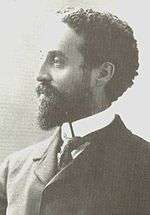Horatio Dresser
| Horatio W. Dresser | |
|---|---|
 | |
| Born |
January 15, 1866 Yarmouth, Maine, United States |
| Died |
March 30, 1954 Boston, Massachusetts |
| Nationality | American |
| Occupation | Minister, author |
| Known for | Author of New Thought |
| Religion | New Thought |
| Parent(s) | Julius A. Dresser and Annetta Seabury Dresser |
Horatio Willis Dresser (1866–1954) was a New Thought religious leader and author.
Early life
Dresser was born January 15, 1866 in Yarmouth, Maine to Julius and Annetta Seabury Dresser. His parents were involved in the early New Thought movement through their study with Phineas Parkhurst Quimby. During his teens, Dresser's father was embroiled in a controversy with Mary Baker Eddy, the founder of Christian Science, whom he accused of stealing Quimby's concepts and using them as a basis for Christian Science.[1]
Horatio Dresser was admitted to Harvard in 1891, but dropped out in 1893 upon the death of his father. Ten years later he returned to Harvard, completing his Ph.D. in 1907.[2]
New Thought
In 1895, Dresser became involved with the Metaphysical Club of Boston, a group which Dresser would later refer to as the "first permanent New Thought club".[3] That same year, Dresser published his first book, The Power of Silence. In 1896, Dresser founded the Journal of Practical Metaphysics. Two years later, this journal was merged into The Arena, for which Dresser was subsequently an associate editor. The following year, 1899, Dresser founded another New Thought magazine, The Higher Law. He was a past president of the International New Thought Alliance.
Controversy
In 1921, after the Library of Congress made Quimby's papers available, Dresser compiled and edited a selection of Quimby's works, The Quimby Manuscripts. In this work, Dresser re-opened the controversy concerning Quimby and Mary Baker Eddy, attacking Eddy in a chapter as well as the appendix of the book; for example:
1885. Mrs. Eddy collects her "facts" in "Historical Sketch of Metaphysical Healing" ... tries to show that Quimby was a mere mesmerist: alleges that she left [manuscripts] with him in 1862.[4]
Personal life
Dresser married Alice Mae Reed in 1898. He was described, in an enthusiastic 1900 Atlanta Constitution article, as:
Tall and slender, with a finely modeled head, which is poised on a magnificent pair of shoulders; his general athletic appearance indicates something more than mere student ... His delivery is plain, straightforward, and unadorned with the flowers of rhetoric.[5]
Dresser taught at Ursinus College in Philadelphia, Pennsylvania from 1911-1913. In 1919, Dresser became a minister of the General Convention of the Church of the New Jerusalem, a denomination built around the teachings of Emanuel Swedenborg, briefly serving as a pastor of a Swedenborgian church in Portland, Maine.
He died March 30, 1954 in Boston, Massachusetts.[6]
Bibliography
- The Power of Silence, 1895.
- Education and the Philosophical Ideal, 1900.
- A Physician to the Soul, 1908.
- A History of the New Thought Movement, 1919.
- The Quimby Manuscripts, 1921.
- A History of Ancient and Medieval Philosophy, Thomas Y. Crowell Company, 1926.
- Outlines of the Psychology of Religion, Thomas Y. Crowell Company, 1929.
References
- ↑ "Horatio Willis Dresser." Religious Leaders of America, 2nd ed. Gale Group, 1999. Reproduced in Biography Resource Center. Farmington Hills, Mich.: Gale, 2010. http://galenet.galegroup.com/servlet/BioRC. Document Number: K1627500347.
- ↑ "Horatio Willis Dresser." Religious Leaders of America, 2nd ed. Gale Group, 1999. Reproduced in Biography Resource Center. Farmington Hills, Mich.: Gale, 2010. http://galenet.galegroup.com/servlet/BioRC. Document Number: K1627500347.
- ↑ Dresser, Horatio (1919) A History of the New Thought Movement, Thomas Y. Crowell, p. 183.
- ↑ Dresser, Horatio W. (1921) The Quimby Manuscripts, Kessinger Publishing edition 2003, ISBN 978-0-7661-4052-3, p. 434.
- ↑ "Horatio Dresser Lectures to a Large Audience", Atlanta Constitution, April 17, 1900, p. 6.
- ↑ "Horatio Willis Dresser." Religious Leaders of America, 2nd ed. Gale Group, 1999. Reproduced in Biography Resource Center. Farmington Hills, Mich.: Gale, 2010. http://galenet.galegroup.com/servlet/BioRC. Document Number: K1627500347.